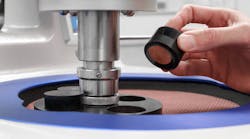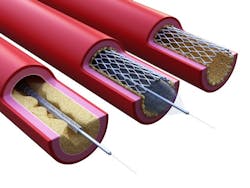The automation trend is aiding multiple industries. Often in highly regulated industries, such as in medical, automation need to meet or exceed the quality of production or testing while also increasing output to be commercially viable. Medical grinding and polishing can take long periods of time and be labor-intensive. This is one area where automation is able to meet all regulations, improve output, and even potentially improve the quality of production.
Though inspection is a common and necessary function of all manufacturing, the process is even more important for medical implants. For these products, the quality assurance lab will take samples from parts from the production floor or out of inventory for inspection. The lab sections the sample and encapsulates it into a protective polymer mount. This process is followed by a series of grinding and polishing actions to efficiently remove sectioning damage. In addition, this process levels and cleans the specimen surface to enable accurate inspection.
Shown is a polished Ti64Al surface using polarized light.
Grinding-Polishing Is the Last Step Before Inspection
Grinding uses fixed abrasives at the point of cutting—the abrasive particles are generally bonded to paper or a platen—for fast stock removal. The process entails three to five steps using progressively finer abrasive grit before polishing steps are carried out.
Polishing removes the artifacts of grinding while maintaining the integrity of the sample. When correct polishing is carried out, one can then see the true microstructure of the sample/specimen using optical and electron microscopy. Additional tests using a hardness tester can also be performed.
For high-production manufacturing, component testing is generally essential. An example is the application of coatings to orthopedic implants (e.g., hydroxyapatite coating for better biocompatibility with bone tissue).
These coatings and related alloys present metallurgical preparation challenges and demand careful considerations due to their high likelihood of outer structural and microstructural damage during sectioning and grinding/polishing. How efficiently the procedures are carried out and the resultant quality of the sample are crucial for high-volume medical part production.
This figure shows a corresponding differential interference contrast image (DIC) revealing topographic details of the polished surface.
Traditional manual methods of sample preparation involve long, tedious steps to reveal the true microstructure of a component. The latest developments reflect a thorough understanding of the principles of material removal in grinding and polishing.
Improving the Sample Preparation Process for Grinding-Polishing
These new approaches take into consideration the initial sectioning damage and how each grinding and polishing step reduces the damage level and its corresponding residual structural damage. Here are six impacts for improving this process that semi-automatic grinding-polishing machines have on high-volume quality assurance labs:
Faster throughput. For high-volume production operations, quality assurance labs are busy through the entire eight-hour shift, and in some cases more than 24 hours. Going from rough cut to polished finish can take up to an hour. Newer grinding-polishing systems take 6 to 8 minutes off the process with the added advantage of processing multiple samples simultaneously.
Reducing cross-contamination. Newer machines have self-cleaning features that apply water and spin the platen at a high speed. As the platen spins, debris is removed and the machine is rinsed clean, greatly reducing the potential for cross-contamination.
Reducing operator fatigue. With a manual machine, a day of testing can mean a lot physical exertion, leading to errors as time moves on and making this approach unsuitable for high-volume labs. The problem is the need to perform the task manually on a machine that either has a raised platen, or else having to rest the wrists on raised edges and lips during grinding and polishing stages.
Stents help keep coronary arteries open and reduce the chance of a heart attack. A stent is inserted into the clogged artery with a balloon catheter. The balloon is inflated, and the stent expands and locks into place. This holds the artery open and allows blood to flow more freely.
The advantage of semi-automatic grinder-polishers is that the machines do the work of applying pressure to the sample during a preparation routine without the need of an operator manually handling the samples. Once the samples are loaded on the machine, the operator can press the start button and walk away until it is time to reload new samples on the platen.
Processing consistency. Along with handling multiple samples, semi-automatic grinder-polishers provide consistency by applying the same force for each sample as well as the ability to adjust the forces to match different sized specimens.
Repeatability. Semi-automatic grinding-polishing machines can provide a touchscreen to enable the technicians to enter in processing routines for the different materials. The technician can enter the routine on the color touchscreen and recall it from memory when that batch of parts comes into the lab. Panel functions can include time, speed, single/central force mode, head rotation, force, pause/stop buttons, and what actions were used (on/off).
- Fresh or recirculated water
- Platen
- Auxiliary dispensing
Technicians then only have to deal with cleaning the sample between grinding steps.
Reduced vibration. Most manual grinding-polishing machines have sheet metal bases. A cast-aluminum base on semi-automatic machines greatly reduces vibration during grinding for a more consistent, higher-quality sample.
Medical Products Depend on Accurate Analysis
In the quality assurance process for manufacturing products used to replace human body parts, the grinding-polishing process involves multiple steps that require the selection of proper surfaces and abrasives at each point in the process. The goal is to provide an acceptable surface for examination. While any kind of grinding-polishing system can provide this kind of finish, semi-automatic machines can enable the quality assurance process to keep pace with the high-volume manufacturing happening on the plant floor.




